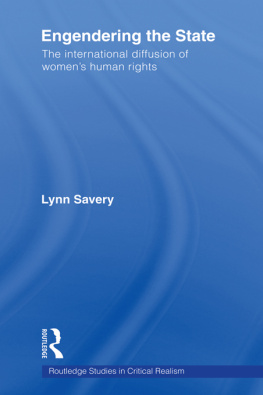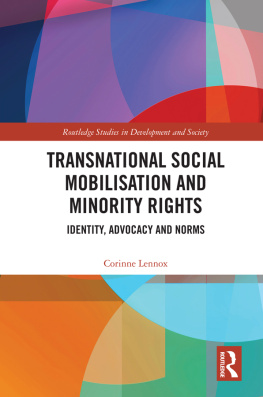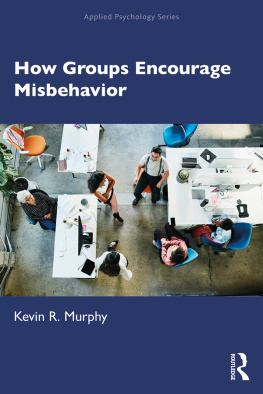Stanford University Press
Stanford, California
2009 by the Board of Trustees of the Leland Stanford Junior University.
All rights reserved.
No part of this book may be reproduced or transmitted in any form or by any means, electronic or mechanical, including photocopying and recording, or in any information storage or retrieval system without the prior written permission of Stanford University Press.
Printed in the United States of America on acid-free, archival-quality paper
Library of Congress Cataloging-in-Publication Data
Horne, Christine.
The rewards of punishment: a relational theory of norm enforcement / Christine Horne.
p. cm.
Includes bibliographical references and index.
9780804771221
978-0-8047-6022-5 (pbk. : alk. paper)
1. Social norms. 2. Interpersonal relations. I. Title.
HM676.H67 2009
303.37dc22
2008041878
Typeset by Westchester Book Group in 10/14 Minion
Preface
A S A STUDENT IN GRADUATE SCHOOL, I WAS INTERESTED IN the relation between law and the informal pressures exerted within communities. I soon realized that to understand the connection between the twobetween rules enforced by the state and those maintained through interpersonal relationshipsI needed to know something about norms. I needed to understand how they emerged and why they were enforced. I turned to the sociological literature but found few answers. The research across disciplines was equally messy. It contained many different ideas about what norms are, why they matter, and what we need to know about them.
I began to try to understand norms for myself. I focused on enforcement. This was partly because of my interest in the relation between law and norms and how investment in one might affect the other. It was partly because enforcement appeared to be the most tractable element of norms to get a handle on. And it was partly because I saw enforcement as crucial, both theoretically and practically. One might begin to study norms by trying to understand the emergence of particular rules. I chose not to start there, reasoning that whatever the rules were, if they were never enforced, they might not matter much.
I began developing my ideas and looking for a setting in which to test them. None of the settings I considered, however, gave me the kind of purchase on evaluating causal relations that I was looking for. In the midst of this search, I took a course on experimental methods and decided to take advantage of that opportunity to explore whether it would be possible to test my ideas in the lab. I discovered that it was.
Since then, I have continued to develop my understanding of norm enforcement and to use experimental methods to test theoretical predictions. This work has produced a series of journal articles. No single article tells the larger story. Each on its own is merely a small piece of the puzzle. In addition, the papers were written for experimentalists. Norms are important in a range of settings, however. Many people are interested in themincluding those who do not do experimental work. I decided to write a book that would put together the pieces of the story in one place for a broad audience.
I describe the argument in nonformal ways, avoiding the use of technical language. I use concrete examples to illustrate the abstract ideas. The problem with examples is that they never perfectly match the theory and so are less precise than the theory itself. They are useful, however, for conveying the gist of an idea.
I also present the empirical support for the theory, including brief descriptions of the series of lab experiments that I conducted and their results. Readers who are interested in the methodological details can find them in the methods appendix and in the original published articles.
Finally, I explore some of the implications of the theory. While I believe that lab experiments are a powerful tool for testing causal explanations, I also believe that, for theory to be useful, it must shed light on substantive questions that people care about.
Michael Hechter encouraged me in this journey from the start. Michael is intensely curious and never takes the easy way out. His questions pushed me to develop my ideas in ways that I would not have done otherwise. I have appreciated his continual support, both in graduate school and since.
Linda Molm introduced me to experimental methods. She taught the graduate course in which I discovered that experiments might provide a useful toola way of testing the theoretical ideas I was developing. Since graduate school, I have benefited from my association with the Group Processes scholars in the American Sociological Association who furthered my education in both theory and experimental methods. I appreciate the many people who have provided intellectual insight, feedback, and personal and professional support along the way. I am indebted to Nobuyuki Takahashi for his patient programming assistance. And I am grateful to my research assistantsin particular, Chien-Fei Chen, Anna Cutlip, Karen Madden, Patience Payne, and Ben Scoll.
Larry and Gulsima sat through many conversations about the book. I appreciate their support for the project. Gulsima gave repeated bedtime admonitions to me to work after she was asleep and frequently expressed the hope that Mom would not mess up on her book. Larry was a wise sounding board as the project took twists and turns.
1 The Problem
F OR CENTURIES, WOMEN IN CHINA PRACTICED FOOTBINDING. Footbinding involved folding the foot of a young girl under itself and wrapping it tightly with bandages. The result was that the foot grew to be no more than a few inches long. Women with bound feet were unable to walk normally. They experienced pain and complications, including gangrene, amputation, and even death. Despite these damaging effects, women perpetuated the practice, making sure that their daughters feet were bound. Footbinding was almost universal among the Chinese and persisted for hundreds of years. Numerous reform efforts failed. Laws against footbinding did nothing to discourage it. Efforts by Western missionaries to inform the Chinese of world opinion about the practice had no effect. But thenin one of the greatest social transformations of the twentieth centuryfootbinding disappeared in a single generation (Mackie 1996, 2006). Why, given its painful and damaging effects and the efforts to stop it, was the practice of footbinding so widespread and so prolonged? And how, after all the failed efforts, was it finally eliminated?
Modern Western societies typically try to solve social problems using one of three tools: government, with its power to penalize problematic behavior; market incentives, with their ability to motivate productive activity; and education and the internalization of appropriate values. None of these approaches, however, accounts for the demise of footbinding. Laws failed to stop the practice. There is no evidence that markets affected it. And education efforts had little impact. None of the strategies upon which modern societies typically rely explains the persistence and demise of footbinding.
What does? In the late 1800s, British romance novelist Mrs. Archibald Little moved with her new husband to China. More than other British wives, she sought to understand the people around her (Croll 1990; Little 1899). Little became very concerned about the practice of footbinding. She traveled through China studying the practice and the attempts to end it. At one point in her travels, she came across a small community in which the residents had pledged not to bind their daughters feet and had promised that their sons would marry natural-footed women. Consistent with that pledge, the residents did not practice footbinding. Little recognized the significance of what the community had accomplished. Its example stimulated the creation of Anti-Footbinding Societies in which members made the same promise (Mackie 2006). These societies led to the end of footbinding. They worked because they greatly reduced the negative social consequences of unbound feet. Those earlier social pressures had been strong. Girls whose feet were not bound risked remaining single. But once Anti-Footbinding Societies existed, mothers no longer needed to fear for the futures of daughters with unbound feet. Norms mandating footbinding dissolved. The practice disappeared.











